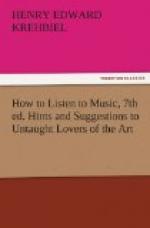“These fragmentary, scattered melodies were the wandering, floating, nebulous part of a great whole, that they fully answered the conditions for the production of an harmonious unity which would comprehend the very flower of their essential properties, their most unique beauties,” and “might be united in one homogeneous body, a complete work, its divisions to be so arranged that each song would form at once a whole and a part, which might be severed from the rest and be examined and enjoyed by and for itself; but which would, none the less, belong to the whole through the close affinity of subject matter, the similarity of its inner nature and unity in development."[D]
[Sidenote: The Czardas.]
The basis of Liszt’s Rhapsodies being thus distinctively national, he has in a manner imitated in their character and tempo the dual character of the Hungarian national dance, the Czardas, which consists of two movements, a Lassu, or slow movement, followed by a Friss. These alternate at the will of the dancer, who gives a sign to the band when he wishes to change from one to the other.
FOOTNOTES:
[D] Weitzmann, “Geschichte des Clavierspiels,” p. 197.
VII
At the Opera
[Sidenote: Instability of taste.]
[Sidenote: The age of operas.]
Popular taste in respect of the opera is curiously unstable. It is surprising that the canons of judgment touching it have such feeble and fleeting authority in view of the popularity of the art-form and the despotic hold which it has had on fashion for two centuries. No form of popular entertainment is acclaimed so enthusiastically as a new opera by an admired composer; none forgotten so quickly. For the spoken drama we go back to Shakespeare in the vernacular, and, on occasions, we revive the masterpieces of the Attic poets who flourished more than two millenniums ago; but for opera we are bounded by less than a century, unless occasional performances of Gluck’s “Orfeo” and Mozart’s “Figaro,” “Don Giovanni,” and “Magic Flute” be counted as submissions to popular demand, which, unhappily, we know they are not. There is no one who has attended the opera for twenty-five years who might not bewail the loss of operas from the current list which appealed to his younger fancy as works of real loveliness. In the season of 1895-96 the audiences at the Metropolitan Opera House in New York heard twenty-six different operas. The oldest were Gluck’s “Orfeo” and Beethoven’s “Fidelio,” which had a single experimental representation each. After them in seniority came Donizetti’s “Lucia di Lammermoor,” which is sixty-one years old, and has overpassed the average age of “immortal” operas by from ten to twenty years, assuming Dr. Hanslick’s calculation to be correct.




